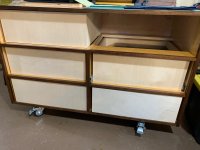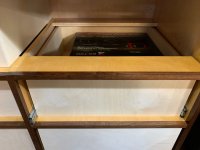Bugsysiegals
Member
- Joined
- Mar 19, 2016
- Messages
- 893
For those of you who build frameless cabinets, how many of you add horizontal stretchers between the drawers? I'm building some shop cabinets, added them to the first cabinet which is still WIP, and wondering whether it's worth adding them to the rest of the cabinets or if it's a waste of resources in addition to locking me into predefined heights which cannot be changed later on ...
Besides this, I'd intended to have a wide top drawer for longer rules/fences etc. but discovered the top started to sag so I'm converting to 6 drawers instead. That said, my middle partition is to short and I'm wondering if I should break down another sheet in order to get a full partition or use some vertical stretchers front/back ... I'm not sure if this is enough support for the cabinet and drawer slides with only 2-4 mounting points depending on their widths?
View attachment 1 View attachment 2
Besides this, I'd intended to have a wide top drawer for longer rules/fences etc. but discovered the top started to sag so I'm converting to 6 drawers instead. That said, my middle partition is to short and I'm wondering if I should break down another sheet in order to get a full partition or use some vertical stretchers front/back ... I'm not sure if this is enough support for the cabinet and drawer slides with only 2-4 mounting points depending on their widths?
View attachment 1 View attachment 2


